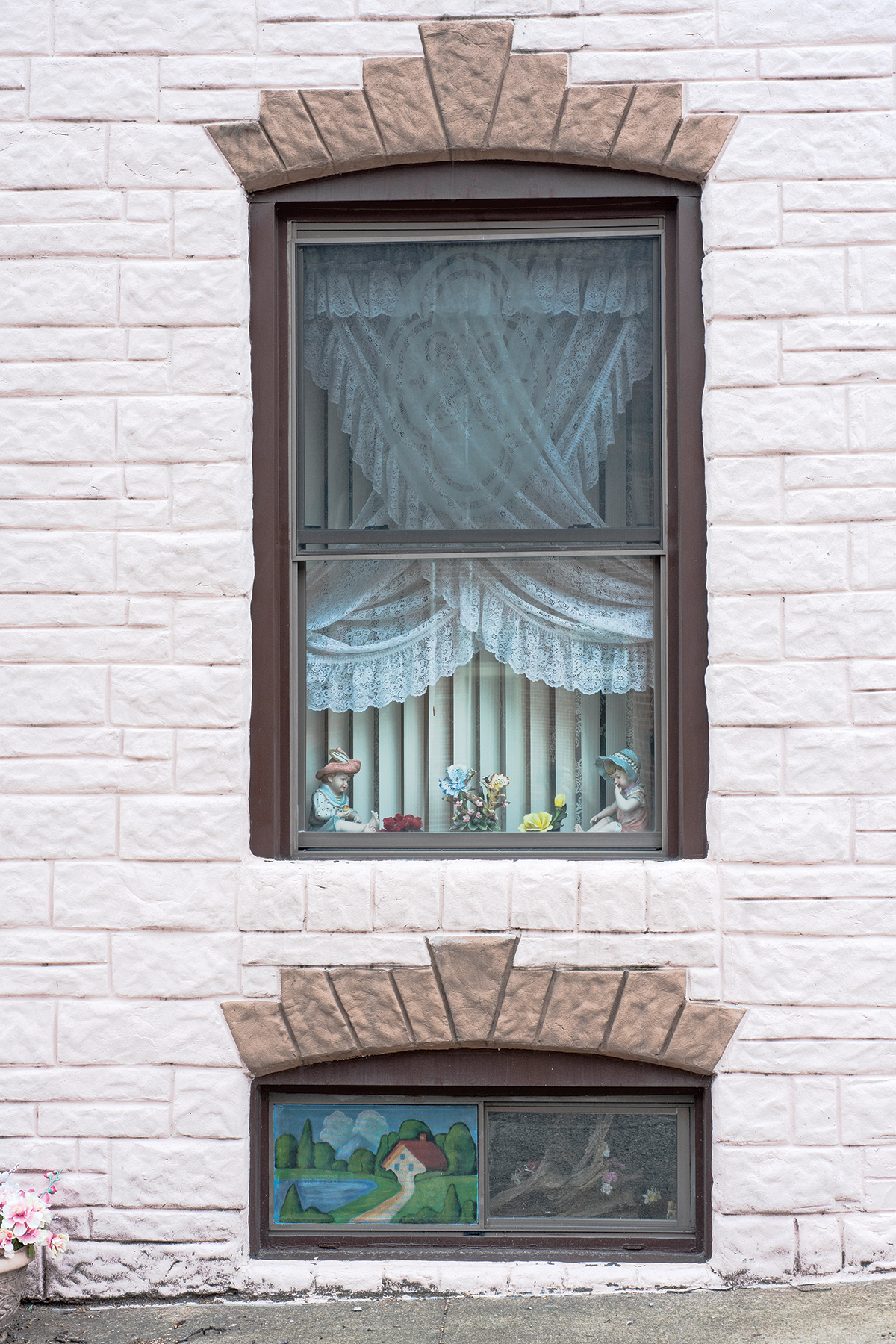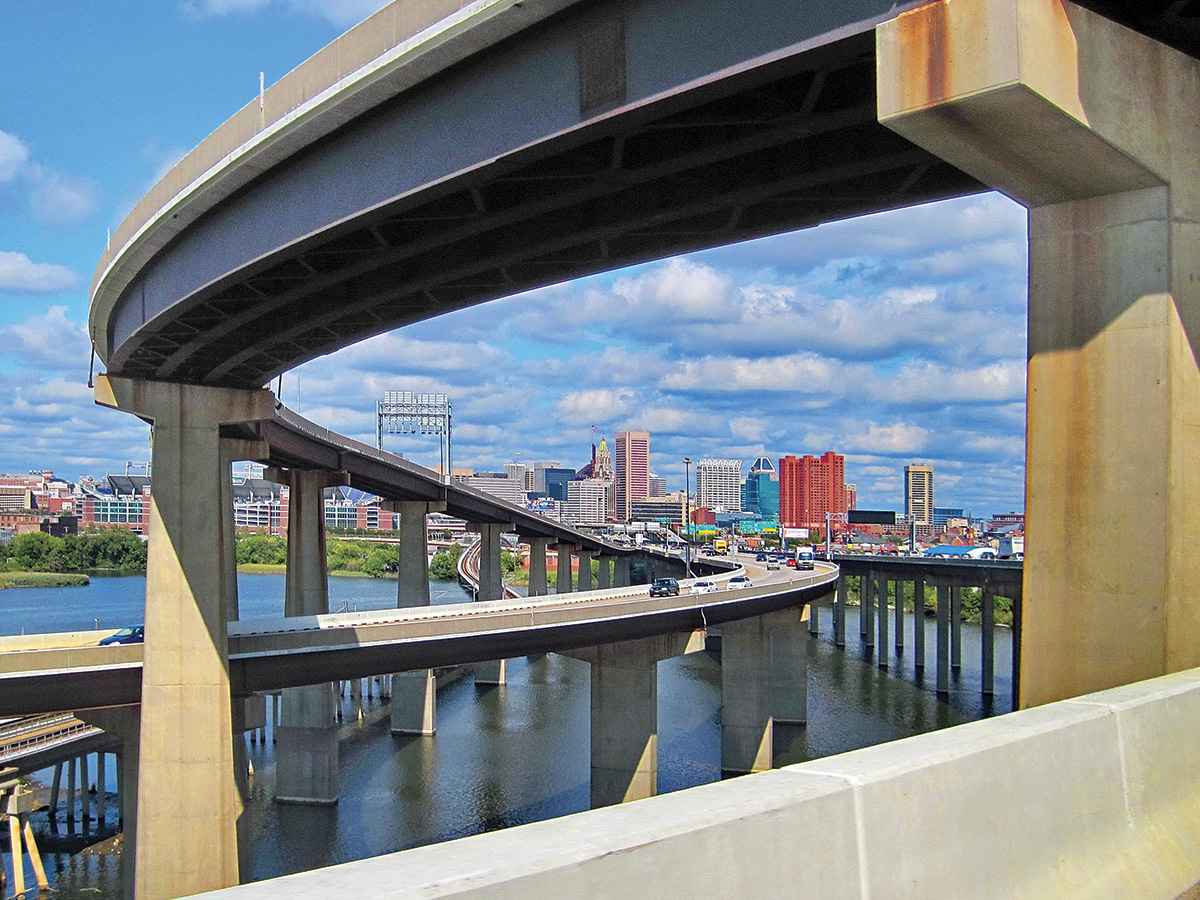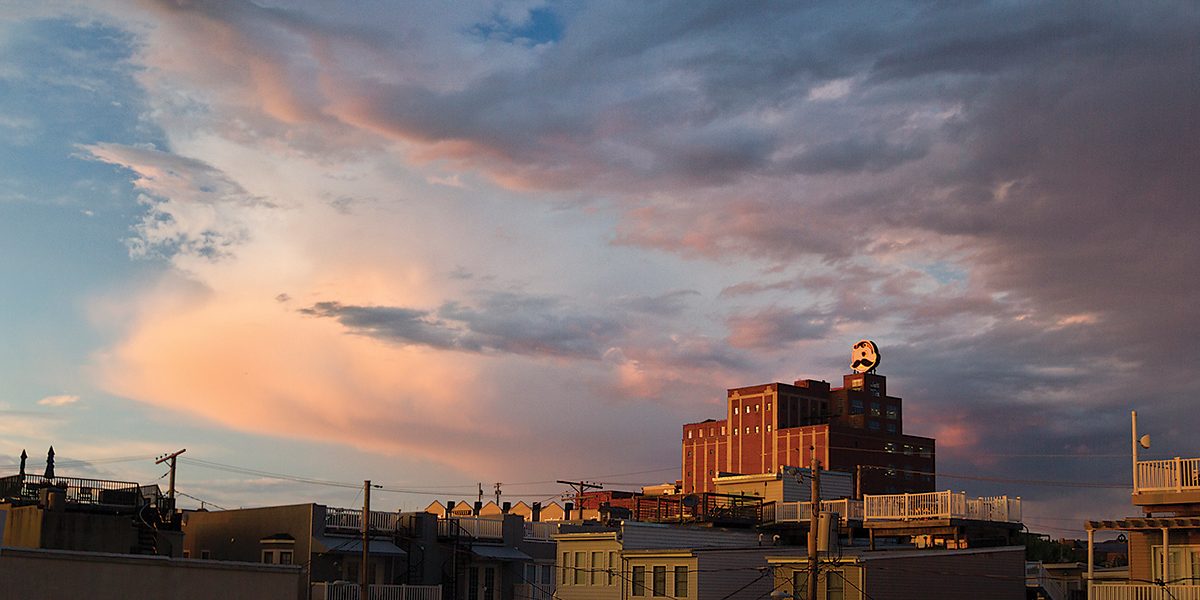History & Politics
Then & Now: Essay
The harbor communities continue to change, but the vestiges of the old neighborhoods are still shaping Baltimore.
A light snow falls on the railroad tracks in Fells Point as mostly thirtysomething couples pile into a chartered bus for a Saturday tour of Federal Hill and Locust Point. Not a history tour, per se, but a RE/MAX-sponsored homebuyer’s expedition of exposed-brick living rooms, granite-countertop kitchens, ceramic-tile baths, and panoramic views from two-tiered rooftop decks.
“Not sure you’re all going fit into that house,” jokes an older man, stepping onto his marble stoop as the couples traipse into the rehabbed row home next door. Upstairs, M&T Bank Stadium’s purple seats are visible from a brand-new deck. Below, across the alley, an elderly woman in sturdy shoes shakes out a carpet.
The bus feels out of place here, struggling to navigate the narrow streets in “the neighborhood once known as South Baltimore”—as a real-estate broker puts it. There’s also a lot of unappreciated local history passing outside the black-tinted windows—an original painted screen on East Gittings Street, the former Southway Bowling Center duckpin lanes on the corner of West Hamburg Street where Babe Ruth once rolled (now gone condo, of course), the Cross Street Market, the 1890’s brick public school repurposed as the contemporary-art gallery School 33 Art Center.Even Formstone—the ersatz siding John Water’s dubbed the “polyester of brick”—goes unrecognized as a peculiar Charm City legacy. “I guess some of the homes were done in large stone because it was cheaper than brick?” inquires a Capitol Hill lobbyist, looking to take advantage of Baltimore’s relatively inexpensive housing market.
 “Actually, that’s a façade,” a real-estate agent explains.
“Actually, that’s a façade,” a real-estate agent explains.
In truth, the tour never quite reaches Locust Point, which as everyone who grew up on the peninsula will tell you, begins at Rallo’s Restaurant on Lawrence Street—even though Rallo’s is gone and it’s Big Matty’s Diner now. It’s unfortunate because if there is one place you’d like to take a busload of soon-to-be Baltimoreans to help them understand everything that underlies this town’s singular culture and eccentricity—it’s Locust Point. The first official port of entry for Maryland; Baltimore was born on these piers.
Indeed, you can make the case that nearly everything we think of as quintessentially Baltimore—Bawlmerese, blue crabs, Old Bay, Edgar Allan Poe, H. L. Mencken, Eubie Blake, Corned Beef Row, The Block, Preakness hats, Camden Yards, John Waters, Natty Boh—came out of a roiling mash-up of Old South heritage, blue-collar jobs, and the immigrants who streamed through what was once the busiest immigration center below the Mason-Dixon line.
“Absolutely, you can trace it all back to the blending of Southern culture and [African-American] migration, Northern industry, and the influx of European immigrants—first mixing at the port and its neighborhoods,” says Mary Rizzo, an American Studies Ph.D. and co-editor of
The Public Historian journal. “Baltimore’s character, it’s uniqueness, the dialect, all of it, is a kind of amalgamation of these very different things coming together—with a little Appalachia thrown in,” adds Rizzo, who has studied the city’s love affair with the working-class “Hon” women of old Baltimore. “It’s all threaded through these neighborhoods.”
And here’s what makes Baltimore unique. There’s gentrification, sure. In Locust Point and other ethnic port neighborhoods, warehouses have been converted into trendy condominiums. But there’s also remnants of old Baltimore everywhere. Not just echoes or artifacts, but the real deal. Next to a $450,000 rehabbed row home or trendy restaurant, there might be a family-owned business that’s been around for a century. That older man stepping onto his marble stoop? He or his wife might have cleaned that very stoop 60 years ago with Bon Ami powder and a scrub brush, as was custom. Of course, lots of cities have old-school neighborhoods, but few have been able to integrate the old and new as seamlessly as Baltimore has around the port.
So, if we were starting a tour, we might do it at 1308 Beason Street, the three-story, brick Immigration House, which is where Locust Point-native Bill Hughes, the 76-year-old son of a longshoreman father and Irish immigrant mother, stands a few weeks later. Built in 1904, next to an even older German church, this is where arrivals to the city stayed awaiting a family from the old country to take them in. Three years after its construction, in the peak year of U.S. immigration, 60 steamers with 66,000 immigrants—Poles, Russians, Ukrainians, Czechs, Slovaks (following earlier waves of Germans and Irish) docked at Locust Point. They poured into the shipbuilding, cargo, and railroad industries—B&O Railroad was the first common-carrier railroad company—and massive manufacturing plants, producing everything from sugar and spice to soap at Tide Point. (Yes, named after Procter & Gamble’s detergent factory.)
Hughes, however, is smiling and pointing up to the top of Silo Point, the 24-story luxury apartment tower that was once the world’s largest grain elevator. “We used to play dice up there when we were kids,” he laughs. “We’d wave and yell down to the cops, but they couldn’t come up and get us because it was owned by B&O.” He learned to swim off the pier next to Under Armour’s campus, which took over the Procter & Gamble facility, and recalls buddies swimming to the Broadway Pier in Fells Point on a bet.
Relatives still live in his childhood home on Hull Street, but old Baltimore, inevitably, is receding in Locust Point and the other harbor neighborhoods. “There’s the culture clash, but there’s jobs,” he says, mentioning Under Armour and the port’s rebound in the last decade, adding that the only real complaint he hears is about parking. Overall, he’s happy to see young families again using Latrobe Park, where he once saw Southern High School’s Al Kaline, the future Detroit Tiger Hall of Famer, hit three home runs.
He’s got one more story that’s revealing: “Before my time, Cardinal Gibbons used to row a skiff back and forth between Our Lady of Good Counsel and St. Bridgid in Canton every Sunday, doing double duty.”
To his point, though separated by water, the Locust Point-Canton association runs deep. It was at the current home of the Baltimore Museum of Industry on Key Highway where Platt and Company Oyster Packers—patent holders of the tin can—launched the canning boom that filled Canton’s shoreline. In fact, Boston Street, according to 83-year-old Dr. John Charlton, who directs Baltimore Visitor Center tours, was named by Boston Irishmen recruited to the canneries. This was before the Locust Point arrival of Polish immigrants who he says, “didn’t want to live with the Germans” in South Baltimore and ferried to live and work in Canton. (His own German great-grandmother, Charlton volunteers, ran a Fells Point dry goods shop before marrying a Norwegian sea captain who’d wandered into her store.)
“Every city claims to be a city of neighborhoods,” says Rizzo, “but in Baltimore, it’s actually true.” And it’s because of the close-knit, ethnic neighborhoods, in which newcomers felt supported—from Locust Point and South Baltimore, to Canton, Highlandtown, Fells Point, Little Italy, Greektown, the Jewish community around Lloyd Street’s first Maryland synagogue, and enclaves beyond the harbor—that each group thrived. It also explains how Baltimore’s quirky culture developed—and stuck.
“Out of such insular places, come eccentric characters and odd cultural practices, however, it’s more than that,” Rizzo says. “You could pick and choose eccentric characters from any city. The thing that really makes Baltimore unique is its embrace of its weirdness—the darkness of Poe—by those who stayed behind in its neighborhoods. Because not everybody did. In Philadelphia, for instance, with the Founding Fathers, history is very serious business, but in Baltimore’s there’s always this edginess to it.”

The nice coincidence is that Baltimore’s stubborn refusal to let go
of its irascible characters and history—the modern manifestations of
which include HonFest, the Charm City Roller Girls, Mr. Boh, the Stoop
Storytelling Series, and our pro football team’s name—is actually
considered by urban experts crucial to rebuilding a vital city. The
reclaiming of the abandoned warehouses around the harbor and ongoing
mixed-use repurposing? That’s more than mere cost-savings and nostalgia.
It’s showcasing Baltimore’s authentic roots and character.
“Think
about it,” says Rizzo, “Baltimore can’t offer, say, more sunshine or
space than Orlando or Phoenix. What it does have—that those cities
don’t—is this eclectic history and its neighborhoods.” The vestiges of
which, as has been noted, are almost, but not quite, extinct, if you
know where to look.
For example, as in Locust Point, Canton row
houses and churches remain from the turn of the 20th century. So does
the public library—frequented by a young Barbara Mikulski, the daughter
of Polish bakers—which began lending books in 1886. Family-owned A.F.
Bialak & Sons Florist, founded in 1920, also remains, along with
O’Donnell T.V. and Repair, started by a World War II radioman named
Budreski, and Kurek’s Hardware, located in the first floor of an
O’Donnell Street corner row house. And, not far away, saved this winter
by the “new Baltimore” owners of Bad Decisions bar, 94-year-old
Ostrowski’s Famous Polish Sausage is still in business, too.
“My
grandfather started in the hardware business in 1932,” says Bill Kurek,
66, putting his brooms and mops out on the sidewalk on a recent morning.
“I was born upstairs.” Like everyone of his generation, he says, his
first date was at Matthew’s Pizza on Eastern Avenue, the city’s oldest
pizzeria, established in 1943. Movies meant either the
Patterson—renovated and flourishing as home to the Creative Alliance
today—or the Grand, where the Enoch Pratt Free Library’s Southeast
Branch sits. “There was a Little Tavern next door to the Grand,” Kurek
says. “You’d get a movie ticket for a quarter and then a burger for 15
cents.”
He also chuckles at an ironic twist of gentrification over
the last 20 years: “When I was growing up, a Highlandtown girl wouldn’t
go out with someone from Canton—Canton was considered the wrong side of
the tracks.” But he says, “You knew everybody and everybody knew you.
You know the tagline for Hamm’s beer?” he continues, pointing to Brewers
Hill, also given a second life as a mixed-use commercial/residential
development. “‘The Land of Sky-Blue Waters.’ Of course, National
Bohemian’s was ‘The Land of Pleasant Living.’” Our joke growing up was,
‘You know what’s in-between? O’Donnell Street.’”
A drive down
Eastern Avenue (atop buried streetcar tracks that ran all the way to the
roller coaster at the Bay Shore amusement park at North Point State
Park) still provides an almost surreal juxtaposition of old and new
Baltimore. First, there’s the Greektown restaurants and bakeries; then
the Highlandtown library bust of Frank Zappa, native son of a Sicilian
immigrant; and the Patterson marquee. Next, historic Patterson Park and
the colossal monument to General Casimir Pulaski—who managed in one
lifetime to fight both the Russian army in Poland and British troops in
the American Revolution.
There’s the Ukrainian Catholic Church’s
golden domes; a row-house taxidermist; Patterson Bowling Center, the
oldest U.S. duckpin lanes; Tochterman’s Fishing Tackle, two years shy of
its centennial and billed as America’s oldest tackle shop; and Krakus
Deli, sausages hanging inside, and advertised in English and Polish on
its website as the best East Coast Polish deli. Billie Holiday’s
childhood home, the Frederick Douglass-Isaac Meyers Maritime Park, as
well as The Horse You Came In On Saloon—said to be the last place Edgar
Allan Poe drank—sit only blocks away.
The toggling between this
history, the new upscale Fells Point and Harbor East redevelopments, and
the latest expressions of Baltimore’s immigrant story—new Latino
restaurants, groceries, and businesses—extends all the way through Fells
Point and Little Italy. Of course, Harbor East, created nearly out of
whole cloth, wasn’t even around when 84-year-old Tom Scilipoti, the son
of Italian immigrants, played sandlot football and little league
baseball in the area.
“We played right there at the end of
President Street,” recalls Scilipotti. “It was an empty lot. There was a
lumber yard nearby [near the Four Seasons Hotel Baltimore], and
afterwards we’d grab a couple of long pieces of wood and make a diving
board to jump off into the water.”
Scilipoti followed his father
into the barbering business, installing a classic, red, white, and blue
pole outside his Bank Street row house where he raised three kids with
his wife Concetta—also the daughter of Italian immigrants. Later, he
switched to photography, opening his studio in an Eastern Avenue row
house, shooting, among the portraits and graduations, Mayor Thomas
D’Alesandro Jr.’s inauguration, his daughter Nancy Pelosi’s wedding,
Mickey Mantle and Whitey Ford out with the boys in Little Italy, and
President John F. Kennedy’s 1962 helicopter landing in Patterson Park—a
huge event in the Catholic neighborhood. He’s also contributed photos to
the weekly Baltimore Guide for 64 years.
Whether people call it
gentrification or not, it’s an improvement, says Scilipoti, who goes
down to the Broadway Market, established in 1786, for breakfast
everyday. He’s thrilled to see the ongoing commercial, residential, and
public projects around the harbor.
“That area, Harbor East, was
filthy, it was nothing but empty warehouses and trash for years. Fells
Point? Canton? They’re beautiful today. Fells Point was a slum when I
was growing up, you never went down there,” he says. “Canton smelled
like tomatoes.”
When asked if there’s been a loss of community
amongst all the change—or if he has a sentimental feeling for the time
when neighbors regularly scrubbed their marble stoops together—as in the
renowned photo by Baltimore Sun photographer A. Aubrey Bodine, the
affable Scilipoti smiles. “Things change,” he says. “That’s just the way
it is.
“And let me tell you, because people forget,” he adds.
“The reason everybody was scrubbing those white marble stoops all the
time was because of the black soot and smoke billowing from the oil
refineries and factories down at the port. I don’t miss that.”
